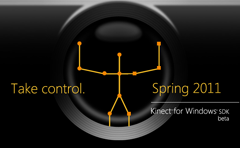Microsoft has released its Kinect for Windows SDK beta, bringing the motion-control and voice-recognition technology to developers and researchers.
Microsoft had originally designed the Kinect controller as a way to play Xbox 360 games via gesture and spoken words, in the process targeting those same casual gamers who had made the Nintendo Wii – and its own unconventional controllers – such an enormous success. In terms of sales, the company succeeded, with millions of customers snatching up a Kinect unit within weeks of its November 2010 release.
Controls hacked
However, tech pros soon found a way to hack the Kinect’s 3D camera, which translates the movements of a user’s body to a digital avatar. Videos soon became to appear on YouTube, demonstrating what the next-generation hardware could do aside from virtual fencing and dancing: painting 3D images in mid-air, say, or tethering Kinect’s motion controls to a robot.
At first, Microsoft did not approve. “Microsoft does not condone the modification of its products,” a company spokesperson told CNET on 4 November, 2010. “Microsoft will continue to make advances in these types of safeguards and work closely with law enforcement and product safety groups to keep Kinect tamper-resistant.”
However, before Microsoft’s legal counsel could begin printing off those cease-and-desist letters, the company executed an abrupt about-face. In a 19 November, 2010, interview with NPR, Alex Kipman, Microsoft’s director of incubation for Xbox, insisted that Kinect had not been hacked, and that the company had deliberately left the device open to modification.
“Hacking would mean that someone got to our algorithms that sit on the side of the Xbox and was able to actually use them, which hasn’t happened,” Kipman told the radio show, according to a transcript. “What has happened is someone wrote an open-source driver for PCs that essentially opens the USB connection, which we didn’t protect by design, and reads the inputs from the sensor.”
Academic research
From that point on, Microsoft highlighted its apparent intention to offer Kinect’s technology to academic institutions, with an eye toward boosting the latter’s research. According to Microsoft Research, system requirements for those downloading the SDK beta include a Kinect for Xbox 360 sensor; a computer with a dual-core, 2.66-GHz (or faster) processor; a Windows 7-compatible graphics card with support for DirectX 9.0c capabilities, and 2GB of RAM.
Required software includes Windows 7, Visual Studio 2010 Express (or other 2010 edition), and Microsoft .NET Framework 4.0.
Microsoft itself intends to use advances in 3D sensing for products beyond gaming. In late 2010, the company acquired Canesta, a maker of 3D-image sensor chips and camera modules that can be embedded in a variety of consumer products, including laptops and vehicle dashboards.
“There is little question that within the next decade we will see natural user interfaces become common for input across all devices,” Jim Spare, president and chief executive of Canesta, wrote in a 29 October, 2010, statement posted on the startup’s website. “With Microsoft’s breadth of scope from enterprise to consumer products, market presence, and commitment to NUI, we are confident that our technology will see wide adoption across many applications that embody the full potential of the technology.”
By the beginning of March, some 10 million Kinect units had sold worldwide.





